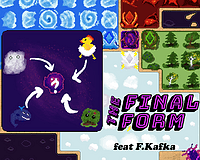Devlog #3 — Movement & Pattern System

Posted May 24, 2025 by Rakudajin

Context: Movement & Painting
In Final Form, you play as a celestial being terraforming a planet in order to ascend to the next existential level. To make terraforming an engaging core mechanic, I wanted to add a puzzle-like layer to the painting process — but not so much that it overwhelms. That’s where the Turn-Based Strategy side comes in — each move is a small tactical challenge based on how your movement and attack patterns interact with the terrain.
The inspiration here came heavily from the board game Onitama. Each turn, you:
- Move to a new tile using a specific movement pattern.
- Paint the surrounding tiles with your current terraforming pattern.
The Rune System
In the original jam version of the game, each creature had a fixed set of four movement patterns and an area-based attack. While I liked the puzzle structure, playtest feedback gave me low marks for "controls" — it felt too restrictive and confusing.
So I rebuilt the system into something more flexible: the Rune System.
Each unit (including enemies) equips one move rune and one attack rune. These define what patterns they can use.
Move Rune Types:
- Walk – simple, short-range movement (like a chess king).
- Fly – long-range, linear, but limited control (rook-like, but limited by minimal range).
- Jump – more complex movement with chained hops (like a knight, but with multiple jumps).
Attack Rune Types:
- Splash – large, fixed shape centred on the player; powerful but low control.
- Blast – directional patterns (like firethrowers or lasers); you pick the direction.
- Throw – small, precise AoEs within a range; flexible but less efficient.
Currently I’ve designed 3–5 runes in each category, and the player can freely combine them. You can go wild with a chaotic Jump+Splash, or play it safe with a calm Walk+Throw combo. Each combo has pros and cons.
Runes also have levels. As you level them up, their patterns expand and unlock new effects or passive skills (more on that in a future post).
During the Night Phase, you keep using the same system — but now instead of painting terrain, you fight Voidborn enemies. They also use unique rune patterns. I’ll cover them in a later devlog.
Visual Design
Currently, I’m using simple tile highlights for movement — it works, but I’d like to replace it with shaders down the line.
As for rune visuals, I tried to design patterns that look vaguely rune-like. I also color-code them:
- The stone’s color shows whether it’s a movement or attack rune.
- The rune’s color is either based on rune type or element (for element-locked runes).
I might add some glow or other flair eventually, but for now, I’m focused on building the actual game systems.
Implementation (Godot)
Here’s how it works under the hood:
- Each pawn has equipment slots, including slots for move/attack runes.
- The turn controller grabs the patterns directly from the equipped runes.
- Runes are defined as objects using a single presets script, which makes it easy to balance and tweak them all in one place.
It’s still early, but I’m aiming for modularity and flexibility — and it’s working pretty well so far.
That’s it for the movement and pattern system — one of the game’s core pillars alongside the tile-coloring system I described in Devlog #2.
Next time, I’ll talk about skills or enemies during the night phase.
Thanks for reading! I’d love to hear your thoughts — is this kind of mechanic fun to you? Clear enough? Too simple or too weird?